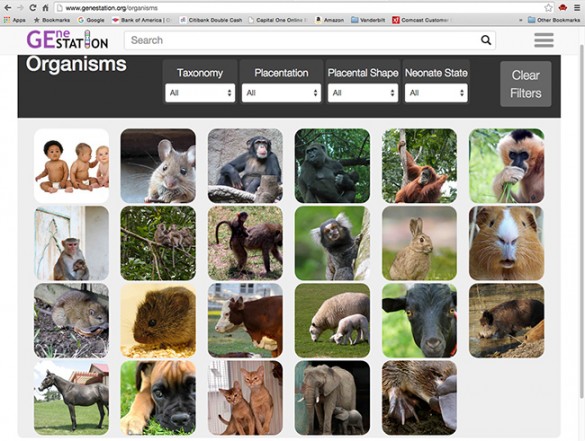
Mother Nature (aka evolution) has been particularly guarded when it comes to her secrets regarding human pregnancy, which has made it particularly difficult for medical researchers seeking answers to the complications of gestation and childbirth, such as preterm birth, which is the leading cause of infant mortality worldwide.
To lift this veil of mystery, an interdisciplinary team of biologists and medical researchers have created a new platform, which they call GEneSTATION (its name stems from a play on the words “gene” and “gestation”), that is specifically designed to leverage the growing knowledge of human genomics and evolution to advance scientific understanding of human pregnancy and translate it into new treatments for the problems that occur when this complex process goes awry.
The new online resource is described in an article published on Nov. 11 by the journal Nucleic Acids Research. It integrates diverse types of “omics” data (genomics, proteomics, transcriptomics, etc.) with life history information on pregnancy and reproduction from 23 species of mammal. These are linked with a number of special clinical databases with information about human-pregnancy-specific diseases.
“Given the importance of the subject, it’s shocking that we know so little,” said project leader Antonis Rokas, professor of biological sciences at Vanderbilt University.
A big part of the problem has been that no other mammal provides a satisfactory model for human pregnancy and gestation. Researchers who study other human organs – kidney, liver, heart, bone etc. – have generally been able to find animals with organs that are very similar to those in humans. As a result, they have been able to learn a great deal about how the human organs work by studying their animal counterparts.
Although mammals ranging from mice to humans use basically the same organs to nurture pregnancies and give birth, the dramatic differences in the structures of these organs have limited the value of studying other mammals.
“It’s something of a paradox,” said Rokas. “Although the mode of reproduction is highly conserved in mammalian evolution, several of the organs associated with pregnancy, such as the placenta, are in fact among the most variable.”
Furthermore, pregnancy involves extremely complicated interactions between genetics and environment,” added Patrick Abbot, associate professor of biological sciences at Vanderbilt University and co-author of the study.
The resulting limitations in the scientific understanding of human gestation and pregnancy have emerged as a major obstacle to finding effective treatments for the complications of pregnancy. For example, preterm birth has become the leading cause of death in newborns and in children under the age of five. In the U.S. and around the world today, more than one in 10 of all births are preterm.
Growing recognition of this problem has prompted a number of different funding agencies to begin major research programs in the area. One is the National Institutes of Health’s Human Placenta Project. Another is the March of Dimes’ Prematurity Research Centers program “dedicated to solving the mysteries of premature birth.”
The origin of the GEneSTATION project was a series of discussions among Rokas, Abbot and Louis Muglia, who was vice chair for research affairs in pediatrics at Vanderbilt University Medical Center. Muglia subsequently moved to the Cincinnati Children’s Hospital Medical Center where he became the coordinating principle investigator of the March of Dimes Prematurity Research Center Ohio Collaborative, which is supporting the project, where Rokas, Abbot and Ken Petren of the University of Cincinnati are leaders of one of the collaborative’s five research themes.
“I’m very excited about the prospect that GEneSTATION represents,” said Muglia. “You couldn’t have done this ten years ago because the data just didn’t exist.”
In order to address this problem, Rokas, whose research until recently was centered on the evolutionary genomics of fungi, and Abbot, whose studies focus on understanding the evolution of cooperation, together with Rokas lab postdoctoral research associate Kriston L. McGary, tried thinking outside of the box.
“GEneSTATION is a new way to organize the information and to look at the problem,” said Abbot. “We hope that it will allow researchers to use the variability of mammalian pregnancy as a tool to attack problems like preterm birth and we hope it will bring fresh, new minds to study pregnancy-related problems.”

An example of how this new platform works is research being conducted by team member Tony Capra, assistant professor of biological sciences at Vanderbilt.
Capra used GEneSTATION to compare the regions of the human genome that regulate gene activity in the placenta across 20 mammalian species. “In particular, I looked for regions that were conserved in other mammals but show a large amount of change in humans,” he said. “When I shared the results with my colleagues in Cincinnati, they told me that they had independently found that one of regions that I had identified was often deleted in families at high risk of preterm birth!”
Vanderbilt University Medical Center Associate Professor David Aronoff, who directs the Vanderbilt Pre3 Initiative, is an early adopter of the platform. “The availability of GEneSTATION is a major leap forward in efforts to understand preterm birth. It is directly relevant to the efforts of the Pre3 initiative, which is an interdisciplinary group of faculty and trainees with a shared interest in reducing the burden of adverse pregnancy outcomes and prematurity,” he said.
“At its core, the development of GEneSTATION is the outcome of a collaboration between four amazingly talented trainees, graduate student Mara Kim, class of 2015 undergraduate Brian Cooper, research assistant Rohit Venkat, and Kris McGary,” Rokas said. “Having a world class computing facility on campus also helped,” he added, referring to the Advanced Computing Center for Research and Education, where GEneSTATION was developed.
Additional Vanderbilt University team members are postdoctoral research associate Julie Phillips, graduate student Haley Eidem, postdoctoral research associate Jibril Hirbo, and class of 2018 undergraduate Sashank Nutakki. Scott Williams from Dartmouth College is also a member of the team.